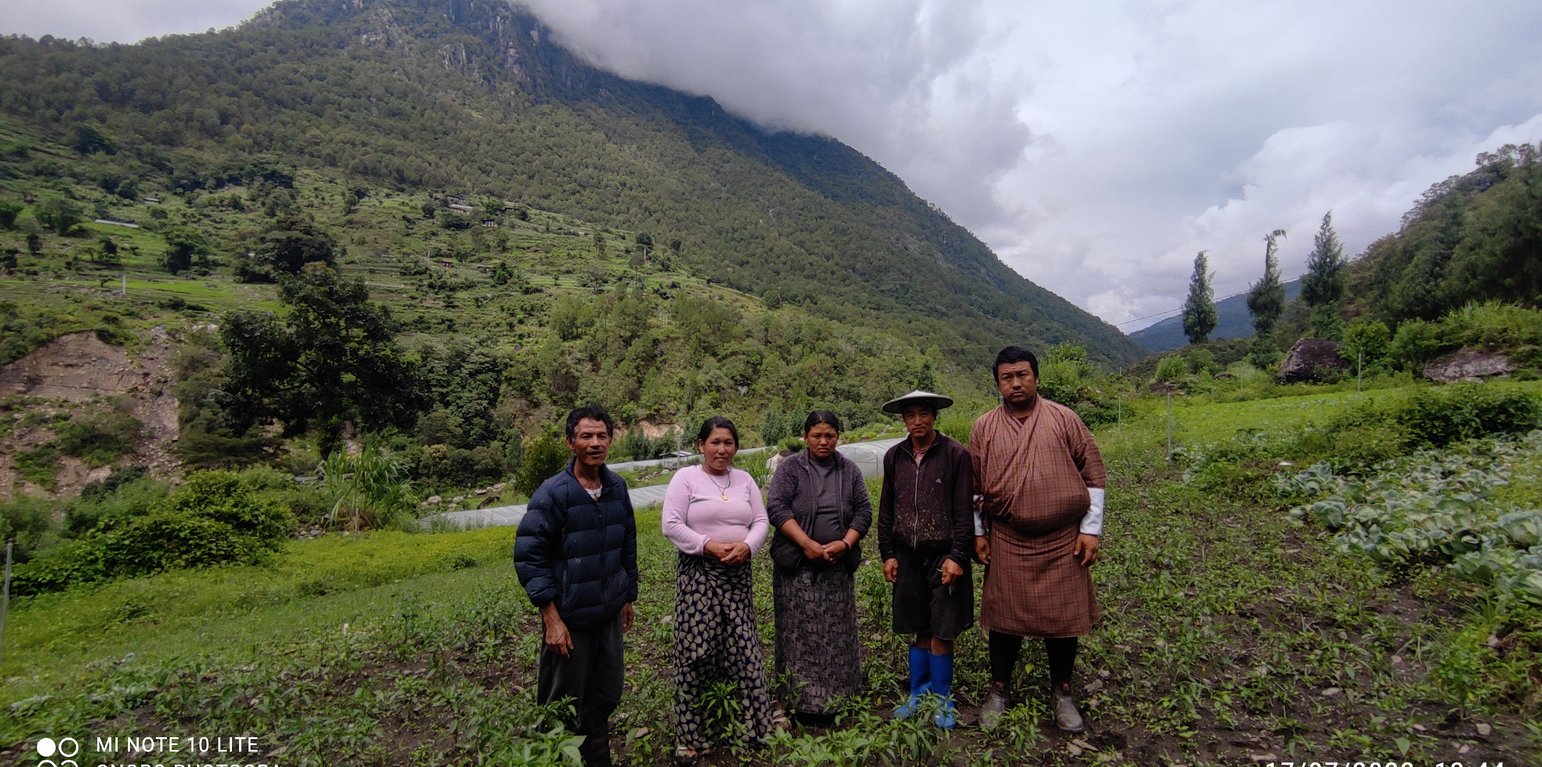Enhancing Agricultural Production Through Fallow Land Reversion
(Bhoutan)
Zhingtong Zhachoed Baedhi Sanam Thoenshug Yarseng Tangni (ཞིང་སྟོང་ཟ་སྤྱོད་འབད་འདི་སོ་ནམ་ཐོན་ཤུགས་ཡར་སེང་བཏང་ནི།)
Description
The approach is to enhance production of local vegetables and fruits through fallow land restoration - under a group established for the purpose.
This approach of reverting fallowed land to productivity encompasses leasing land, working in groups, promoting SLM technologies, and forging market linkages. In this example, the land belongs to the community Lhakang (temple) where the community used to grow maize and pulses to be offered to the Lhakang. However, with increased wild animal depredation, and shortages of irrigation water the land was left fallow. In 2019, with support from the government and the Commercial Agriculture and Resilient Livelihoods Enhancement Program (CARLEP), International Fund for Agriculture Development (IFAD) Project, interested farmers from the community came together, leased the land, and started cultivating vegetables. The reverted fallow land is thus cultivated by the Chuthawoong Commercial Vegetable Farming group which is divided into three subgroups – one of women only - to increase efficiency. The group consist of seven and nine men in two male groups and seven women in one female group. There are no youths involved. The initial development involved the implementation of various SLM technologies such as stone bunding and napier grass strips to reduce soil erosion. Developing market linkages is another characteristic of the approach. The Regional Agricultural Marketing and Cooperatives (RAMCO) linked the land users with three schools to sell vegetables. Furthermore, the group signed a contract with Bhutan Agro Industries Limited (BAIL), Lingmithang (state-owned company) to supply dragon fruit and pineapple for processing.
The main aims and objectives of the approach are to become self-sufficient in vegetables and reduce imports, improve the livelihood and income of the land users and retain youth in agriculture through agricultural mechanization. The methods involved in implementing the approach were consultation among the community leaders and land users, and higher-level consultation with the Gewog Leaders and Dzongkhag Officials, consultation with the Agriculture Research and Development Center (ARDC) Wengkhar and with CARLEP project members.
Stages of implementation included conducting a feasibility study, followed by consultation meetings with the land users. Land development was carried out along with the installation of facilities including fencing, greenhouses, irrigation, and irrigation water storage tanks. After that, the group was formed and bylaws established. Seeds and seedlings were provided by the government.
Stakeholders involved include Gewog officials to develop land lease agreements. The Gewog Extension officer was involved throughout the process in providing guidance and support concerning irrigation, land development, vegetable and fruit cultivation and others. Dzongkhag officials were involved in the feasibility study and planning, and as one of the funding source. CARLEP act as the biggest funding agency to facilitate infrastructure support along with carrying out monitoring activities. ARDC-Wengkhar provided technical support and RAMCO established market linkages.
Land users benefit from increased household income and being self-sufficient in vegetables. The major challenges faced by the land users are distance, as the land is located far away from their houses, and marketing issues, as total production remains above market demand.
Lieu
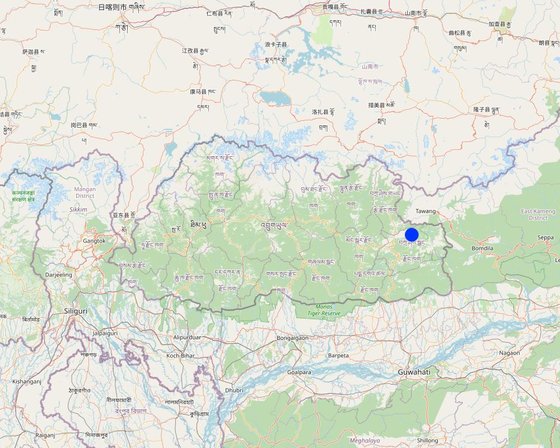
Lieu: Pakaling Chiwog, Radhi Gewog,, Trashigang Dzongkhag, Bhoutan
Géo-référence des sites sélectionnés
Date de démarrage: 2017
Année de fin de l'Approche: sans objet
Type d'Approche
-
traditionnel/ autochtone
-
initiative/ innovation récente locale
-
fondé sur un projet/ programme
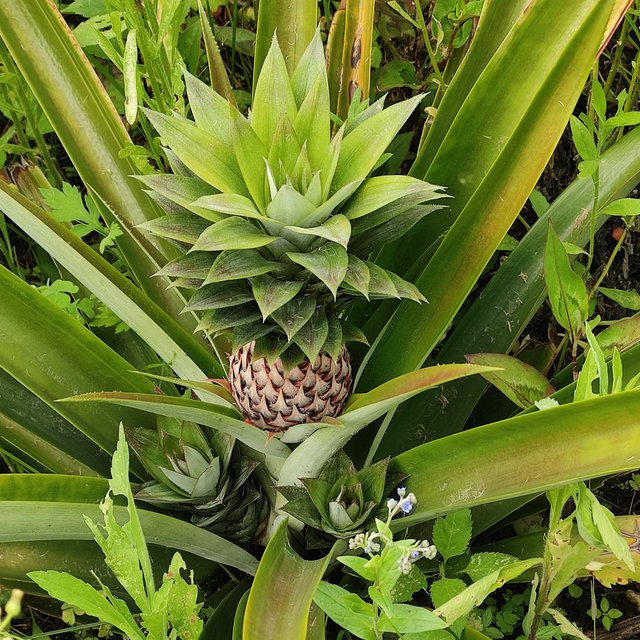
Pineapple cultivation in the reverted fallow land (Ongpo Lepcha)
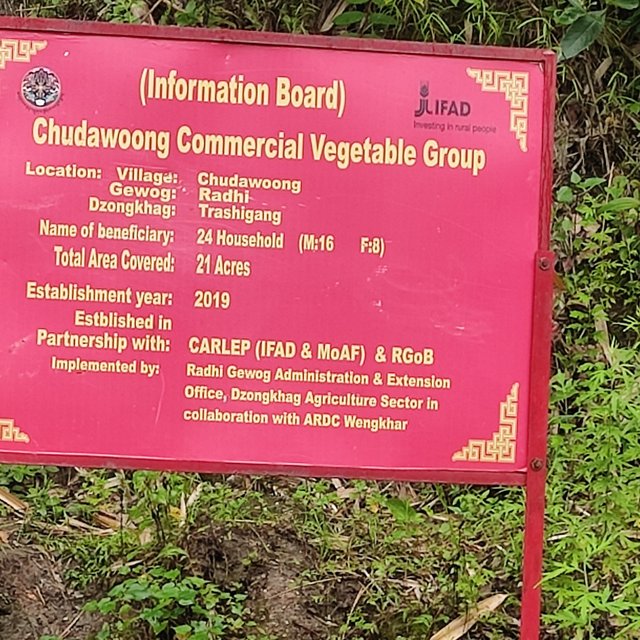
Image showing relevant information of the approach. (Ongpo Lepcha)
Objectifs de l'approche et environnement favorable
Principaux objectifs de l'Approche
The main aim of the approach is to reduce imports by increasing vegetable production, Improve the livelihood and living standard of the land users and retain youth in agriculture through agriculture mechanization.
Conditions favorisant la mise en oeuvre de la/(des) Technologie(s) appliquée(s) sous l'Approche
-
Disponibilité/ accès aux ressources et services financiers: The approach received financial support from various organizations. Dzongkhag Administration (Royal Government of Bhutan) provided Nu. 500,000/-, followed by Nu. 850,000/- from CARLEP-IFAD project and Nu. 90,000 from BAIL.
-
Cadre institutionnel: There is a very good collaboration between the institutions such as Schools and with the BAIL.
-
Collaboration/ coordination des acteurs: Although financial support was provided, the community came together to contribute labour for 300 days per household. The farm is Local Organic Assurance System (LOAS) certified and there is a common understanding to follow the organic guidelines.
-
Cadre juridique (régime foncier, droits d'utilisation des terres et de l'eau): The land belongs to the community Lhakang of Pakaling Chiwog. Out of 100 households, only 27 households were interested and engaged in renting the land for crop production. The Local government had facilitated and the lease agreement was drawn between the Lhakhang and community. The land users have to pay a sum of Nu.7500/- to the Lhakang. The group members can cultivate the land for all time while non group members have no right to object or raise any issues. In case, If the group disintegrates in future, any outsider or member of the community can take up the farming activity with no objections from the others.
-
Connaissances sur la GDT, accès aux supports techniques: The land users had access to technical support Gewog Extension Officer, the Dzongkhag Agriculture officer and Researchers from the ARDC-Wengkhar.
-
Marchés (pour acheter les intrants, vendre les produits) et prix: The groups have a linkage to supply vegetables to the schools and signed the contract with the BAIL, Lingmithang
Conditions entravant la mise en oeuvre de la/(des) Technologie(s) appliquée(s) sous l'Approche
-
Charge de travail, disponibilité de la main-d'œuvre: The land users are engaged in rice cultivation in their own fields and weaving. Therefore, the availability of manpower in the revived land is minimal.
Participation et rôles des parties prenantes impliquées dans l'Approche
Parties prenantes impliquées dans l'Approche et rôles
| Quels acteurs/ organismes d'exécution ont été impliqués dans l'Approche? |
Spécifiez les parties prenantes |
Décrivez le rôle des parties prenantes |
| exploitants locaux des terres / communautés locales |
Land users |
Contributed labour during the establishment of the farm and involved in the cultivation of the vegetables. They are the main actors in the approach. |
| Spécialistes de la GDT/ conseillers agricoles |
Gewog Extension officer, Dzongkhag Agriculture officer, Researchers from ARDC-Wengkhar. |
Provides technical support such as training in vegetable cultivation, and setting up irrigation systems. |
| enseignants/ élèves/ étudiants |
Teachers engaged in School Feeding Programme |
Purchase farm produce from the group. |
| secteur privé |
BAIL |
Provides fund support and purchase farm produce for processing |
| gouvernement local |
Gup, Tshokpa |
Involved in developing the land lease agreement. |
| gouvernement national (planificateurs, décideurs) |
Royal Government of Bhutan |
Conduct a feasibility study, and provide financial support. |
| organisation internationale |
CARLEP-IFAD |
Provide fund sources for the establishment of the farm and conduct monitoring. |
Participation des exploitants locaux des terres/ communautés locales aux différentes phases de l'Approche
aucun
passive
soutien extérieur
interactive
auto-mobilisation
initiation/ motivation
The land was fallow for 27 years and in 2007 the land users tried to restore the land by initiating Integrated Agriculture Farm where they cultivated forest trees, crops and livestock. However, with the unavailability of water, the integrated farm was not successful. People informed the government about the need for a water pump and the Gewog Gup shared it in a higher meeting. This was the initiation of the Land restoration approach.
planification
There were numerous meetings involving the land users, Gewog officials, Gewog Extension Officer, Dzongkhag officials, officials from ARDC-Wengkher and CARLEP.
mise en œuvre
Land users and all the stakeholders were involved in the implementation of the approach.
suivi/ évaluation
External monitoring is done by Audit officers from the stakeholders involved, Audit officers from Bumthang for CARLEP, and Audit officers from Samdrup Jongkhar for RGoB.
Internal monitoring is done by the Treasurer of the group.
Diagramme/ organigramme
The flowchart has been developed in consultation with the land users and Gewog Agriculture Extension Officer.
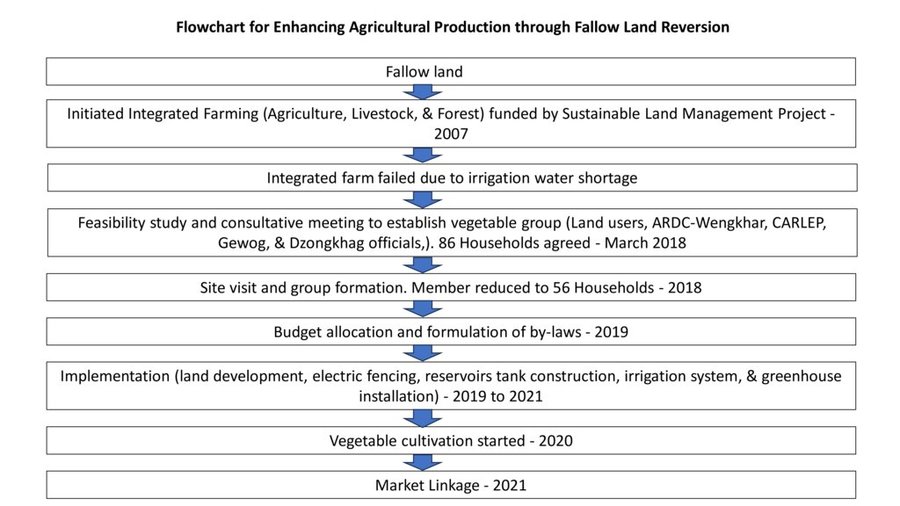
Auteur : Nima Dolma Tamang
Prises de décision pour la sélection de la Technologie de GDT
Les décisions ont été prises par
-
les exploitants des terres seuls (auto-initiative)
-
principalement les exploitants des terres soutenus par des spécialistes de la GDT
-
tous les acteurs concernés dans le cadre d'une approche participative
-
principalement les spécialistes de la GDT, après consultation des exploitants des terres
-
les spécialistes de la GDT seuls
-
les responsables politiques/ dirigeants
Les décisions ont été prises sur la base de
-
l'évaluation de connaissances bien documentées en matière de GDT (prises de décision fondées sur des preuves tangibles)?
-
les résultats de recherches?
-
expériences et opinions personnelles (non documentées)
Soutien technique, renforcement des capacités et gestion des connaissances
Les activités ou services suivants ont fait partie de l'approche
-
Renforcement des capacités/ formation
-
Service de conseils
-
Renforcement des institutions (développement organisationnel)
-
Suivi et évaluation
-
Recherche
Renforcement des capacités/ formation
La formation a été dispensée aux parties prenantes suivantes
-
exploitants des terres
-
personnels/ conseillers de terrain
Formats de la formation
-
sur le tas
-
entre agriculteurs (d'exploitants à exploitants)
-
zones de démonstration
-
réunions publiques
-
cours
Sujets abordés
Soil nutrient management, vegetable production technique, compost making and others.
Service de conseils
Le service de conseils était fourni
-
dans les champs des exploitants?
-
dans des centres permanents
-
On social media (WeChat)
Advisory service in the form of hands on training at site, at gewog centers and online social media forums such as WeChat.
Renforcement des institutions
Institutions ont été renforcées ou mises en place
-
non
-
oui, un peu
-
oui, modérément
-
oui, beaucoup
Décrivez l'institution, ses rôles et responsabilités, ses membres, etc.
The role of the group is to meet their objectives through vegetable production and motivate one another.
Type de soutien
-
financier
-
renforcement des capacités/ formation
-
équipement
Plus de détails
The land users benefit from the approach as the income generated is useful in sustaining their livelihoods. Land users' capacity was built as they were engaged in the training and implementation of various SLM technologies. The group received equipment such as an irrigation system, electric fencing, greenhouse and others.
Suivi et évaluation
The monitoring and evaluation are done by the donors to evaluate the success of the approach. The monitoring includes site visits and verifying the documents on the purchase and sale of the inputs of the produce and its economic benefits to the land users.
Financement et soutien matériel externe
Budget annuel en dollars US de la composante GDT
-
< 2 000
-
2 000-10 000
-
10 000-100 000
-
100 000-1 000 000
-
> 1 000 000
Precise annual budget: sans objet
CARLEP project and Royal Government of Bhutan
Les services ou mesures incitatives suivantes ont été fournis aux exploitants des terres
-
Soutiens financiers/ matériels fournis aux exploitants des terres
-
Subventions pour des intrants spécifiques
-
Crédits
-
Autres incitations ou instruments
Soutiens financiers/ matériels fournis aux exploitants des terres
Following are the financial support received by the group. 16 numbers of fabricated greenhouses where the land user paid 20% of the amount and 80% was funded by the donor. 100% funding was provided by the donor for the water pump, electric fencing, internal networking of irrigation, cement, grass-cutting machine, seeds and seedlings, water tank and curing shed construction. Labour input was contributed by the land users. The total of Nu. 90,00,000/- (Ninety hundred thousand) was supported for the project.
en partie financé
entièrement financé
Water pump, grass cutting machine
Water pump and grass cutting machine 100% funded by the doner.
intrants agricoles: semences
By RGoB.
Land development
100% machine contribution was done by the government with labour contribution from land users.
infrastructures : routes
By government.
Greenhouse, electric fencing, internal networking irrigation system, curing shed
For greenhouses, 80% was funded by the doner, 20% by land users. For electric fencing, internal networking irrigation system, cement, pipes, curing shed and water storage tank materials were funded 100% by the doner with labour contribution made by land users
La main d'oeuvre fournie par les exploitants des terres était
-
volontaire
-
vivres-contre-travail
-
payée en espèces
-
récompensée avec un autre soutien matériel
Analyses d'impact et conclusions
Impacts de l'Approche
Non
Oui, un peu
Oui, modérément
Oui, beaucoup
Est-ce que l'Approche a autonomisé les exploitants locaux des terres, amélioré la participation des parties prenantes?
The approach improved farm income and their livelihood. It improved stakeholders participation such as schools, Extension officials, and BAIL.
Est-ce que l'Approche a permis la prise de décisions fondées sur des données probantes?
The approach enabled land users and the stakeholders involved to make decisions based on the findings. For example, the land users learned that potato cultivation was not profitable due to insect infestation, so they opted for chili cultivation in the next season.
Est-ce que l'Approche a aidé les exploitants des terres à mettre en œuvre et entretenir les Technologies de GDT?
Land users implemented stone bunding and napier grass plantation to reduce soil erosion which they have maintained very well as it was very efficient in controlling soil erosion. The Napier grass was also sold creating income opportunities.
Est-ce que l'Approche a amélioré les connaissances et les capacités des exploitants des terres pour mettre en œuvre la GDT?
The land users were involved in the SLM technologies establishment under the supervision of the SLM specialist leading to improved knowledge.
Est-ce que l'Approche a amélioré les connaissances et les capacités des autres parties prenantes?
The stakeholders' knowledge was improved greatly as the challenges faced by the land users were forwarded to the stakeholders (SLM specialist/RAMCO). The stakeholders were to address the challenge and in the process, the stakeholder had to develop new techniques and test them on the field which led to improved knowledge of both the parties.
Est-ce que l'Approche a construit/ renforcé les institutions, la collaboration entre parties prenantes?
All the stakeholders and land users worked together to achieve a common goal i.e. increased income for land users and use of fallow land for agriculture production, reduce import.
Est-ce que l'Approche a autonomisé les groupes socialement et économiquement défavorisés?
If the land users are interested, irrespective of their wealth and status, all the land users in the community are allowed to participate in the approach. Therefore, economically disadvantaged groups involved in farming activity have improved livelihood and increased household income.
Est-ce que l'Approche a amélioré l'égalité entre hommes et femmes et autonomisé les femmes et les filles?
The approach has two subgroups with heterogenous members (male and female) and one subgroup has only female members encouraging women's participation in decision-making.
Est-ce que l'Approche a encouragé les jeunes/ la prochaine génération d'exploitants des terres à s'engager dans la GDT?
The approach was initiated to encourage youths to participate in agricultural activities. However, there is no interest shown by the youths. This could be due to low-income generation, poor market access and less or no recreation facility in the approach site.
Est-ce que l'Approche a conduit à améliorer la sécurité alimentaire et/ou la nutrition?
The approach enabled land users to be self-sufficient in vegetables during winter and also generate income by selling the produce. Thus, making the community self-sufficient in vegetables and certain fruits.
Est-ce que l'Approche a amélioré l'accès aux marchés?
The approach linked the land users to the market such as schools and processing units (BAIL).
Est-ce que l'Approche a conduit à des emplois, des opportunités de revenus?
The approach improved the income of the land users as they were able to buy school necessities for their children from the income generated by selling vegetables from the approach site.
Principale motivation des exploitants des terres pour mettre en oeuvre la GDT
-
augmenter la production
-
augmenter la rentabilité/ bénéfice, rapport coûts-bénéfices
-
réduire la dégradation des terres
-
réduire les risques de catastrophe
-
réduire la charge de travail
-
paiements/ subventions
-
règles et règlements (amendes)/ application
-
prestige, pression sociale/ cohésion sociale
-
affiliation à un mouvement/ projet/ groupe/ réseaux
-
conscience environnementale
-
coutumes et croyances, morale
-
améliorer les connaissances et compétences en GDT
-
améliorer l'esthétique
-
atténuer les conflits
Durabilité des activités de l'Approche
Les exploitants des terres peuvent-ils poursuivre ce qui a été mis en oeuvre par le biais de l'Approche (sans soutien extérieur) ?
The approach is sustainable. Even though the market for large quantities of produce is not available. There is a market linkage created with local consumers. Further, the land users can link with the relevant stakeholders to export the produce. Moreover, the land users were well trained in vegetable production to sustain without external support.
Conclusions et enseignements tirés
Points forts: point de vue de l'exploitant des terres
-
Improved production and increased cultivable land is major strength of the approach. With the fallow land reversion and sufficient irrigation water, the land is is able to produce large amount of crop.
-
The approach contributed to improved household income. By selling the crops grown in the revived area, the land users get additional income to support their livelihood.
Points forts: point de vue du compilateur ou d'une autre personne-ressource clé
-
Improved nutrition to the school children as the quality of organic vegetables supplied by the group is better than the imported produce grown in a conventional system with the use of pesticides especially from India.
-
Reduces import as the group sell their produce to the schools and nearby community. The demand for vegetable is met by domestic production, therefore there are fewer commodities imported.
Faiblesses/ inconvénients/ risques: point de vue de l'exploitant des terrescomment surmonter
-
The land is far from the houses of the land users making it difficult for the land users to give constant management and care.
-
Radhi is known as the "Rice bowl of eastern Bhutan" and it is also famous for the Bhuray (type of fabric) gho and kira (National dress). Therefore the reverted land is neglected during peak rice production season and labour demanded by the weaving of the Buray gho and kira high.
-
Due to less market and surplus production. Land users are challenged with marketing of their crops.
Encourage middlemen to purchase their produce and sell it to other parts of the country.
Faiblesses/ inconvénients/ risques: point de vue du compilateur ou d'une autre personne-ressource clécomment surmonter
Références
Examinateur
-
William Critchley
-
Rima Mekdaschi Studer
-
Joana Eichenberger
Date de mise en oeuvre: 19 août 2023
Dernière mise à jour: 30 mai 2024
Personnes-ressources
-
Kinzang Yeshey - exploitant des terres
-
Ten Jamtsho - exploitant des terres
-
Pema Dendup - exploitant des terres
-
Tshering Pelden - exploitant des terres
-
Choni Zangmo - exploitant des terres
-
Pema Wangchen (pemawangchen2010@gmail.com) - Agriculture Extension Officer
Description complète dans la base de données WOCAT
Données de GDT correspondantes
La documentation a été facilitée par
Institution
- National Soil Services Centre, Department of Agriculture, Ministry of Agriculture & Livestock (NSSC) - Bhoutan
Projet
- Strengthening national-level institutional and professional capacities of country Parties towards enhanced UNCCD monitoring and reporting – GEF 7 EA Umbrella II (GEF 7 UNCCD Enabling Activities_Umbrella II)
Références clés
-
Lhamo C. (2021). Agricultural production through fallow land reversion with numerous interventions. CARLEP. Retrieved from https://carlep.gov.bt/agricultural-production-through-fallow-land-reversion-with-numerous-interventions/: https://carlep.gov.bt/agricultural-production-through-fallow-land-reversion-with-numerous-interventions/
